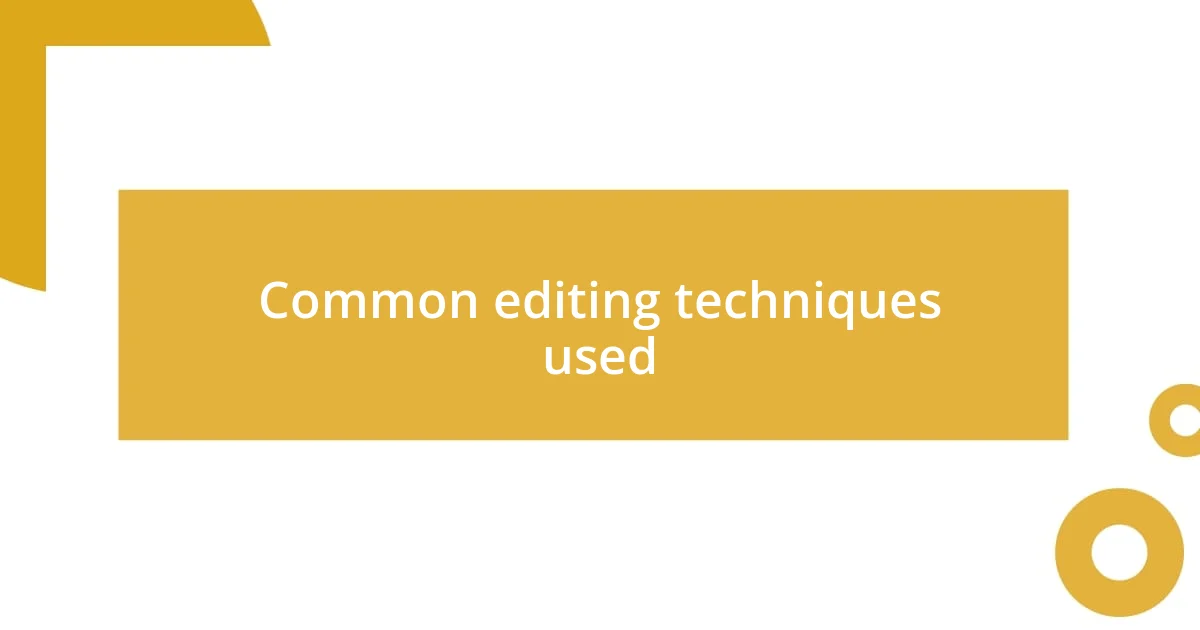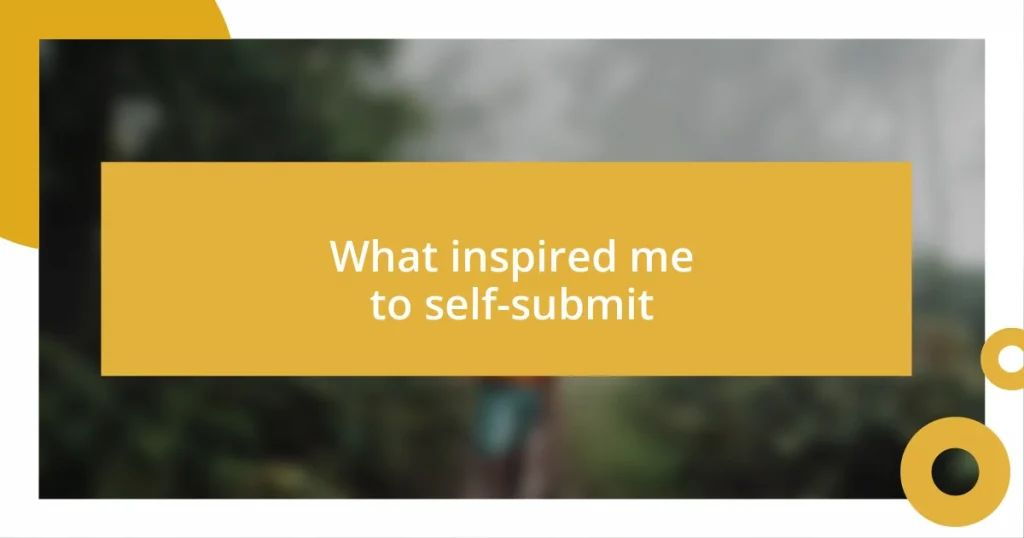Key takeaways:
- Editing is a crucial process that enhances clarity, coherence, and personal voice in writing, transforming rough drafts into polished pieces.
- Revising work reveals inconsistencies and strengthens arguments, making it essential for connecting with the audience and improving overall writing quality.
- Seeking feedback from peers and employing various editing techniques, such as reading aloud and using checklists, fosters improvement and encourages a collaborative environment.

Understanding the editing process
Editing isn’t just a mechanical task of correcting errors; it’s a vital stage that breathes life into your writing. I remember feeling overwhelmed during my first few editing rounds, grappling not only with grammar but the entire flow and coherence of my ideas. Have you ever felt that rush of satisfaction when a piece finally clicks into place? That transformation is what makes the editing process so rewarding.
As I’ve gone through this journey, I’ve realized that effective editing requires a fresh perspective. Stepping away from my work for a day or two always helps me return with a clearer mind. It’s like rediscovering a hidden gem tucked away in a pile of rough drafts. That space allows me to catch errors I might have otherwise overlooked and refine the overall message.
Moreover, editing is a deeply personal experience. Each change I make resonates with my voice and intent. Have you ever questioned whether a particular word truly reflects your feelings? I often find myself wrestling with word choices, but it’s a crucial part of honing my narrative. In this dance between content and clarity, I find that the process ultimately elevates my writing beyond what I initially imagined.

Importance of revising your work
Revising your work is essential for clarity and precision. I’ve often discovered that the second or third time reading through my draft reveals inconsistencies I hadn’t noticed before. Each revision feels like peeling back layers, allowing the true essence of my message to shine. It’s not just about fixing mistakes; it’s about finding the heart of what I want to convey.
Here are some reasons why revising your work is crucial:
– It enhances clarity, making your ideas easier to understand.
– It helps identify gaps in logic or missing information, strengthening your argument.
– It offers the opportunity to refine your voice and style, making your writing more engaging.
– It allows for the integration of feedback, leading to a more polished final piece.
– It encourages a deeper connection with your audience, as your message becomes clearer and more impactful.

Steps to effective editing
The first step I take in the editing process is to read through my draft in its entirety. This initial scan helps me understand the overall flow and catch glaring errors. I find that marking sections that feel awkward or unclear serves as a roadmap for my detailed revisions later on. It’s like taking a scenic walk through my own writing, identifying areas that need some fresh paint.
Once I’ve done a thorough read, I dive into addressing specific elements such as grammar and punctuation. This stage can feel tedious, but I’ve learned to appreciate its importance. I recall a moment when I overlooked a tiny grammar mistake that changed the entire meaning of a sentence. It was a gentle reminder of why each detail matters in the long run.
Lastly, seeking feedback from trusted peers is invaluable. I often invite fellow writers or friends to review my work and share their impressions. Their insights often shine a light on aspects I may have missed, adding depth and perspective to my writing. This collaborative element not only improves my piece but also fosters a sense of community that fuels my passion for writing.
| Step | Description |
|---|---|
| Initial Read | Read through the entire draft for overall flow and glaring errors. |
| Detailed Edit | Focus on grammar, punctuation, and clarity in specific sections. |
| Feedback | Invite peers to review and provide insights for improvement. |

Common editing techniques used
Common editing techniques can greatly elevate the quality of your work. One technique I frequently rely on is line editing, where I focus on polishing sentence structures and word choice. I remember a particular draft where I kept using the word “very.” It felt weak, and after some digging, I swapped it for more powerful adjectives. That little change transformed the entire tone of my piece.
Another essential method is the use of checklists during the editing process. I created a simple checklist that includes common errors I tend to make, such as subject-verb agreement and consistency in verb tense. This practice not only streamlines my process but also keeps me accountable. Have you ever found yourself missing the same mistake repeatedly? A checklist helps combat that frustrating recurring issue.
Lastly, reading aloud is a technique I can’t recommend enough. It puts me in the shoes of my readers, allowing me to hear the rhythm of my writing. I recall a time when I read a passage to myself and realized it sounded clunky. Adjusting those sentences made the message resonate more clearly. Plus, it adds a personal connection to the words. How could something so simple make such a significant difference? It’s all about putting in the work to truly embrace our art.

Tools that aid in editing
When it comes to the tools that aid in editing, I can’t help but mention software like Grammarly or Hemingway Editor. These tools serve as my digital assistants, pointing out grammar issues and offering suggestions to enhance clarity. I recall a draft where I used passive voice excessively, and Hemingway alerted me to that, inspiring me to tighten my prose. It’s amazing how a little digital nudge can steer my writing toward greater strength.
Beyond software, I find that physical tools, like sticky notes and highlighters, ignite my creative process. I often jot down thoughts or specific edits right on the margins of my printed drafts. There’s something satisfying about physically marking up the paper and seeing my thought process unfold. Have you ever felt the tactile pleasure of manually editing? It gives me a sense of ownership over my work that digital notes just can’t replicate.
Lastly, I highly value audio editing tools, especially when I write for online platforms. By recording myself reading my drafts aloud, I catch awkward phrases that my eyes might miss. It’s like having a personal editor who listens carefully to my words. Funny enough, sometimes I discover that what sounds great in my head doesn’t quite translate into spoken form, and that realization often leads to important changes. Isn’t it fascinating how hearing our work can open new avenues of clarity?

Tips for self-editing
I often find that taking a break after finishing a draft is invaluable. When I step away for a day or two, I return with fresh eyes and a clearer perspective on my work. It’s incredible how detachment can unveil issues that were once hidden. Have you ever experienced that moment of clarity after a short hiatus? For me, it’s almost like seeing a friend in a new light.
Another technique I swear by is focusing on one type of error at a time. Whether it’s punctuation, redundancy, or clarity, tackling issues in isolation streamlines my editing process. I remember going through a manuscript where I fixated solely on eliminating filler words. By zeroing in on each theme, I noticed a remarkable improvement in flow and precision. Isn’t it fascinating how breaking down a complex task can make it so much more manageable?
Reading my work backwards is a quirky trick I picked up, and I can confidently say it’s a game-changer. By starting at the last sentence and working my way up, I distill the piece down to its core elements without getting caught up in the narrative. I recall a project where this method exposed inconsistencies that I would never have caught otherwise. Have you ever thought about how switching up your routine can lead to surprising insights? For me, this simple shift can breathe new life into my editing process.

Seeking feedback during editing
Seeking feedback during editing is one of the most enlightening aspects of the process. When I send my drafts to trusted friends or colleagues, I’m often amazed by the fresh perspectives they offer. Recently, a fellow writer pointed out areas of confusion in a piece I thought was crystal clear. It made me realize that what makes sense to me might not translate the same way to others. Have you ever overlooked something so obvious simply because you were too close to the work?
I’ve developed a habit of asking for specific feedback by posing targeted questions. Instead of just asking, “What do you think?” I might say, “Are there any points that feel unclear or need more detail?” This approach encourages more focused responses. I remember one instance where I was struggling with the ending of a story. My friend mentioned that it felt abrupt, which led me to rework it into something more satisfying. Don’t you find that sometimes, a little direction can yield invaluable insights?
Additionally, I embrace the discomfort that can come with receiving feedback. It’s not always easy to hear critiques, but I’ve learned that they’re often stepping stones to improvement. After sharing a particularly personal essay, I felt vulnerable when a reviewer highlighted some emotional gaps. Initially, I hesitated, but I soon appreciated their perspective. That critique prompted me to delve deeper into my feelings, making the final piece far more impactful. Isn’t it fascinating how feedback can push us to explore uncharted territories within our writing?













